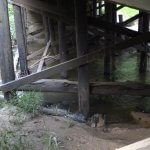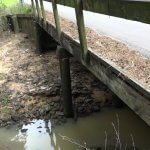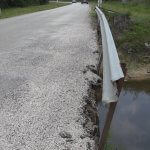The National Bridge Inventory is a response to a series of bridge disasters. In December 1967, the Silver Bridge at Point Pleasant, West Virginia, collapsed, killing 46 people. Hoping to avoid a repeat catastrophe, the following year Congress created the National Bridge Inspection Standards to require uniform bridge inspections across the whole country. Bridges over 20 feet long located on federal-aid highways were required to be inspected at least once every two years. That requirement has since been expanded to all bridges on public roads. We have many bridges in Montgomery County but in the past few weeks three of those have been brought to our attention. One of those bridges is a wooden bridge which spans Caney Creek on Millmac between FM 1484 and Willis Waukegan. The bridge was built many years ago as a wooden bridge and maintained as a wooden bridge. The last time the bridge was inspected was in December 2015. That inspection described the bridge as a wood or timber bridge 145 feet long and 24.3 feet wide. It was estimated in 2014 that approximately 600 cars a day crossed that bridge and that truck traffic was 8% of that number. The substructure was rated as satisfactory with the wooden deck rated as good. The operating rating of the bridge was 39.6 tons (79,200 lbs.) with the inventory rating as 28.7 tons (57,400 lbs.). The bridge appears quite sound on the underside. Since Harvey large logs are wedged up against the bridge structure restricting water flow.
Another bridge is on Millmac between Willis Waukegan and SH 105 in Cut and Shoot. That is a 36 -foot- long bridge which is 24 feet wide. It too was last inspected in December 2015. At the time of the inspection it was a wooden bridge covered in asphalt. It received a fair rating also. The report showed that in 2014 1,240 vehicles passed over that bridge a day with 5% of that traffic being trucks.The bridge was said to have an inventory rating of 16.8 tons (33,600 lbs.). With an operating range of 25.7 tons. It was recommended at the time that replacement of bridge or other structure because of substandard load carrying capacity or substantial bridge roadway geometry. The county currently has it posted for a maximum weight of 15,000 pounds (7.5 tons) per axle or set of axles. The total gross weight on a garbage truck is 54,000 pounds and a Conroe ISD School bus is 18,500 pounds empty and last but not least is a fire truck which weighs at least 40,000 pounds empty. The surface of the road is covered in cracks where the asphalt is sinking. Sinking into what with a wooden deck under it? How can the condition of the wood be determined? One beam is lying in the creek bed. Looking at the sides, nails are coming out and several beams are visibly rotted.
The third bridge has been in the news at least 10 years. On October 25, 2008 a young lady driving down Old Houston Road just south of SH 242 ran off the side of the Dry Creek bridge. The bridge is actually not really a bridge, but an old railroad car covered in asphalt. That is not a bad thing as many of those were used many years ago. That bridge was inspected in November 2015 and had an operating rating of 40.6 tons (81,200 pounds) and an inventory rating of 27.7 tons (55, 400 pounds). At the time it was reported that an average of 840 vehicles a day passed over it of which 1% were trucks. Since that time Old Houston has been put on many truckers GPS units as a cut through to get to the Walmart Distribution Center on Gene Campbell and the traffic has drastically increased. Even once the 18-wheelers make it over the bridge they still need to contend with the sharp curves just before FM 1314 which many motorists have come into with an 18-wheeler in their lane. Several weeks ago the edges of the bridge began to break away, the asphalt began to crumble. A vehicle going over the bridge and hitting the wrong spot could easily put it off in the Dry Creek which is about 4-feet deep currently. Commissioner Clark sent his truck used to repair pot holes to the bridge on April 27th to make the repairs. The only thing done was to dump piles of loose gravel over the holes. It has now caused motorists to move onto the on coming lanes to avoid the piles of rock. Remember the bridge is only 24.6 feet wide. Two vehicles passing each other is tight but passing an 18-wheeler is worse. There has already been one death on the bridge over the years and at least 3 vehicles over the edge in the water. In one of those scenes Grangerland and Bennette Firefighters (now Caney Creek Fire) had to enter the water to remove the female driver, the railings of this bridge are made up of 2×2 angle iron holding a piece of guardrail. One piece of the guardrail has already broken away. Where the bases of those pieces of angle iron are welded to the rail car are twisted and almost broken off. The rail would not hold a vehicle and probably wouldn’t even hold a person who would sit on the guard rail. As far as flood control, a mattress and a box spring are in the water blocking part of its passage. If you note the Google image of the bridge is dated 2008 this is the same year of one of the vehicles ended up in the water. Montgomery County Precinct 4 arrived on the scene and set up cones where the rail had been. A few days later they came back and erected the same rail and a few days later welded a guardrail to the angle iron supports. Almost 10 years and not a thing has changed.



















































